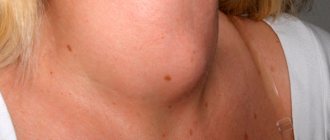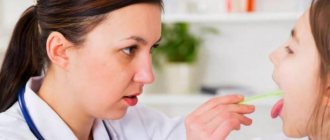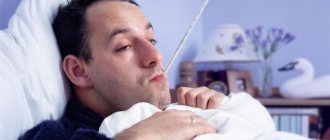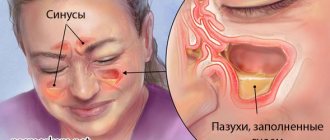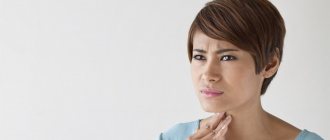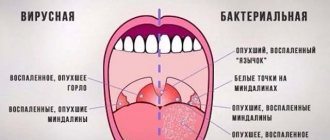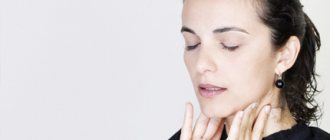It happens like this: a child wakes up in the morning and complains about his throat.
But it just dried out a little during sleep and instantly “goes away” after a cup of tea or warm milk. And no lethargy, fever or anything else that makes mothers feel anxious...
There are many causes for a sore throat. For the most part, when using modern methods and drugs, they are not at all dangerous. But it’s better not to neglect consulting a doctor. At least when the baby’s throat hurts.
Causes of sore throat in children
• Bacterial infections: pharyngitis and tonsillitis (angina).
They are in first place on the list of pathogens that cause a child to feel a sore throat. Do not try to make a diagnosis yourself if there is no laboratory at home: the presence of a bacterial infection can only be determined using a smear and culture in a clinical setting. Such an analysis determines not just the presence of infection, but the extent to which it “responds” to antibiotics. (In other cases, feeding a child with antibiotics is a waste of drugs and child health, because this group of drugs leaves a not very pleasant mark on the body).
Pharyngitis affects the mucous membrane of the larynx, and tonsillitis, also known as tonsillitis, nests on the tonsils. The last bacterial enemy is perhaps the most insidious. The initial symptoms of a sore throat are very similar to the symptoms of another disease - mononucleosis. It, in turn, is also an acute infectious disease that also affects the pharynx and lymph nodes. But the consequences of mononucleosis are much more serious than those of a simple sore throat. Its “traces” in the body remain forever and concern the liver and spleen, changes in blood composition. This disease, the incubation period of which ranges from 10 to 21 days (usually 10), is determined only in laboratories, and confirmed cases of the disease can cause panic at the local sanitary and epidemiological station and quarantine of the sick person for a long period. Adults are rarely susceptible to this disease: by the age of 25, most have already developed antibodies. But teenagers (girls 14–16 years old and boys 16–18 years old), and also, a little less often, children are at risk.
• Viruses.
It’s annoying to realize this, but different pathogens can provoke the same disease. So, you can “catch” both a viral sore throat and viral pharyngitis. Recognizing the virus is not so difficult: aches throughout the body, lethargy, weakness, easy fatigue, a sore throat grows gradually, and the temperature rises.
• Irritation of the mucous membrane of the throat.
This is just one of those cases when a child’s sore throat can be cured by mother’s tea. But more complex situations mean that allergic reactions, exposure to polluted or dry air, and tobacco smoke may occur.
• Laryngitis.
Sometimes a barking cough is added to a child’s sore throat. You shouldn’t fall into despair and sign a death sentence for your child’s lungs and bronchi. This is simple laryngitis, inflammation of the larynx with spread to the vocal cords - a disease less dangerous than most viruses, if, of course, treatment is taken on time and correctly.
There are usually two causes of laryngitis: viruses or excessive tension on the vocal cords the day before. For example, the baby went to football with his dad and was “sick” so loudly that he actually got sick the next morning.
Particular attention should be paid to laryngitis in the youngest: their larynx is narrow and long, and such a cough is dangerous due to attacks of suffocation. Laryngitis cough is a false croup, which in the 21st century is successfully treated by medicine, the help of which you will undoubtedly turn to.
Treatment with unconventional methods
Therapy for infectious ENT pathologies must be comprehensive, pathogenetically and etiologically justified. When carrying out treatment, it is necessary to take into account all pathological factors involved in the development of the inflammatory process. To speed up the healing process, it is necessary to use medications aimed at reducing the activity of pathogens, neutralizing their metabolites and increasing the resistance of the child’s body.
As part of conservative therapy for ENT diseases, the following treatment methods can be used:
- rinsing;
- compresses;
- inhalation;
- physiotherapy;
- medicines.
In the treatment of infectious patients, special attention should be paid to diet.
Inflammation of the throat increases the risk of injury to the mucous membranes from solid food particles. To prevent complications, during drug therapy it is advisable to refrain from consuming foods that irritate the ciliated epithelium - citrus fruits, spicy foods, hot drinks, etc.
The basis of treatment for meningitis is antiviral, antibacterial or antifungal therapy, which depends mainly on the causative agent of the disease. It is carried out exclusively in a hospital setting.
Meningitis is more common in children than in adults, and the number of cases increases significantly in the autumn-winter period. This is facilitated by temperature fluctuations, hypothermia of the child’s body, and limited nutrition (insufficient amounts of fresh vegetables and fruits).
If it hurts your child to swallow, you can use some folk recipes. Such methods include rinsing, irrigating and lubricating with a variety of solutions, decoctions and infusions, which are prepared at home or purchased at the pharmacy. But it must be remembered that treating a child requires great care and consultation with a pediatrician.
If it hurts a child to swallow, every adult should know how to help. So, for infections of any origin, it is recommended to drink plenty of warm fluids, which helps eliminate toxins and prevents dehydration. To do this, teas are brewed from linden, cranberry, rose hip, raspberry, sage, and currant leaves. In order not to irritate the mucous membranes, such teas should not be overly sour.
Effective treatment of the throat consists of comprehensive measures. First of all, it is necessary to ensure an optimal microclimate for recovery in the children's room. It is necessary to do wet cleaning and place containers with water to maintain air humidity of at least 50% and air temperature of no more than 20 degrees to avoid drying out the nasopharyngeal mucosa.
We suggest you read: Which throat suckers can pregnant women use?
Drinking plenty of fluids will help relieve a sore throat. The main thing is that the drink is warm and pleasant. You can give teas with honey and lemon juice, juices diluted with water, fruit drinks, fruit and milk jelly, unsweetened compotes. The child should drink constantly throughout the day. Honey and citrus juices can be given if there is no allergy to these products.
During illness, children should not be given new foods that they have not tried before - they can cause allergies.
You should follow a diet. Sour, salty, fatty, sweet foods, cold and hot dishes are excluded. Marinades irritate the mucous membrane of the oropharynx and provoke a dry cough and sore throat. For the same reason, citrus fruits should not be given to children; they can only be given in the form of diluted juices. Hot food increases hyperemia and can cause burns to the mucous membrane. Cold food contributes to hypothermia of the upper respiratory tract. These factors aggravate the course of the disease and delay recovery.
Food should be warm, soft, easily digestible, and portions should be small. Give vegetables and fruits without peeling. It is best to blend them in a blender and serve as a puree. Vitamins must be present in the little patient’s diet every day. Solid foods should not be eaten so as not to injure the throat.
For bacterial infections, children are prescribed broad-spectrum antibiotics with a preliminary sensitivity test. Since the main causative agent of inflammation of the oropharynx is streptococcus, penicillin drugs (amoxicillin, amoxiclav) are prescribed. These medications are available in suspension, because all mothers know how difficult it is to get their baby to swallow a pill.
In case of a viral infection, the use of interferons at the onset of the disease is highly effective; under their influence, the disease may even recede. Treatment of a throat in children with ARVI does not require antibiotic therapy.
It is also important to know how to relieve pain. This is done through local treatment. Children who already know how to spit should gargle regularly. For this purpose, warm 0.9% saline solution is used. A small child up to one year old can be given irrigation. Take the baby in your arms, tilt your head slightly down and to the side, and spray the solution into the throat from a small syringe. Lollipops with antiseptics under the tongue, which should be given half an hour after meals, will help relieve a sore throat.
When the temperature returns to normal, we treat children with warming compresses and mustard plasters. Newborns have very sensitive skin, so they can have mustard plasters placed through a cloth, or mustard plasters with cells can be placed on the reverse side and the procedure time can be reduced to 5 minutes.
For acute and chronic tonsillitis, the tonsils are lubricated with oil solutions: Lugol's solution or chlorophyllipt. This unpleasant procedure may cause a gag reflex, but it effectively eliminates inflammation.
It is not recommended to remove plaque on your own in case of oropharyngeal infections - this can cause bleeding from the tonsils
How to quickly cure a child’s throat using folk remedies? Here are the simplest and most effective methods.
- make a vodka compress, half vodka with camphor oil. Apply a compress to children over two years old;
- how to relieve pain in the oropharynx: rinse with a saline solution of 2-3 grams of table or sea salt per 200 ml of warm water, 5 ml of lemon or beet juice per 200 ml of water;
- Potato or ether inhalations will help cure a child’s red throat. Sit with your baby over a pan of hot potatoes or water to which essential oils have been added. Cover your head with a blanket and sit for 7-10 minutes;
- the patient can be cured with decoctions of anti-inflammatory herbs;
- for colds, rubbing with honey, camphor oil, goat fat, and butter will help. Do the procedure at night. Lubricate the neck, back, chest, sole with a heated product, put on a T-shirt and socks made of natural fabric, cover the baby with a blanket. In the morning the child will feel much better. This procedure can only be done when the patient has a normal temperature;
- It is good to remove the temperature by rubbing with a vinegar solution: for 200 ml of water at room temperature, 20 ml of regular or apple cider vinegar. It is necessary to reduce the temperature above 38 degrees. Febrile fever is especially dangerous for children from 0 to 4 years old due to immature immunity. If you are intolerant to vinegar, you can place a cloth soaked in cool water on your elbows and knees. Change it as it warms up.
With timely correct therapy, relief occurs on days 3-5, and recovery on day 7.
If the disease drags on for a week or two and the acute symptoms do not subside, there is a high probability of a secondary infection. In this case, you need to show the child to a specialist again. The attending physician will conduct a differential diagnosis and adjust the treatment.
Home diagnostics: a child has a sore throat.
Each of the reasons has its own characteristic signs, by which you can roughly guess the diagnosis while you wait for the doctor. All throat diseases have both common and fundamentally different symptoms.
For example, a sore throat is observed with both pharyngitis and laryngitis. But in the first case, when swallowing, the pain “radiates” to the ear, but in the second, it does not.
• Sore throat is a pain in the throat and head, body temperature up to 38 degrees inclusive, worsening sleep and appetite.
• Pharyngitis is a sore throat and pain when swallowing, which is transmitted to the ears, and a cough is possible.
• Infectious mononucleosis - pain in the head, joints, muscles, and throat when swallowing, weakness and inflammation of the lymph nodes.
• Laryngitis - dryness, burning, sore throat, and later - coughing, wheezing, hissing.
• Diphtheria of the pharynx (acute infectious disease) - severe sore throat, fever, tonsils and mucous membranes near them are covered with a yellow coating, weakness. Accurate diagnosis - only by laboratory smear!
• The common cold – long-lasting sore throat, deep red mucous membrane of the larynx, sometimes runny nose, cough, headache.
• Adenoiditis (inflammation of the adenoids) - constant sore throat, difficulty breathing, sometimes snoring during sleep, “husky” pronunciation and frequent deep sighs. Laryngeal pain from adenoiditis in infants is dangerous due to attacks of arrhythmia and tachycardia.
Rinses
Parents often ask about what to give their child for laryngitis and other throat diseases. Doctors generally recommend rinsing. The following recipes are used for them:
- Eucalyptus decoction, which is known for its antiseptic effect. To gargle, boil a teaspoon of crushed eucalyptus leaves in water and gargle with the solution 2 times a day.
- Sage tea. The effectiveness of this medicinal plant is explained by the presence of cineole, a natural antiseptic. Rinsing with this infusion has an analgesic, regenerating and hemostatic effect. The infusion is prepared from a tablespoon of raw materials and a glass of water.
- An infusion of calendula flowers perfectly relieves irritation of the throat mucosa and disinfects it. To gargle for a child, you need to make an infusion from a teaspoon of dry raw materials and 300 ml of water.
- A decoction of mint for gargling in children gives an analgesic and mild cooling effect. It is used for moderate discomfort in the throat.
- Plantain infusion is used for sore throats in children. To prepare, you need to take 50 g of medicinal raw material and brew it in a liter of boiling water. It is necessary to infuse the product for about an hour, then strain and use for rinsing.
- Gorlia is a very effective medicinal plant when it hurts a child to swallow. To make a decoction you need 15 g of herb and 100 ml of water. The mixture is boiled over low heat and then allowed to brew.
- Chamomile infusion is a well-known and effective remedy for hygiene and treatment of throats in children. A tablespoon of herbs is brewed in boiling water, filtered and rinsed.
Diagnostics: how doctors check why a child has a sore throat
Diagnostics includes, in addition to the initial examination, instrumental and laboratory methods for determining the problem.
Initial examination.
The doctor examines the mucous membrane of the sore throat for typical signs of any disease. Sometimes such an inspection is enough.
Instrumental diagnostics.
Typically, this is laryngoscopy using a laryngoscope (probe) with a tiny video camera - the most accurate way of visual diagnosis.
Laboratory diagnostics.
Includes a general blood test, nasal and throat swabs. A blood test shows the level of leukocytes and, as a result, the degree of inflammation, and smears allow you to determine the composition of the microflora and the type of causative bacteria.
A child has a sore throat: how to treat it?
Having bought half of the pharmacy assortment, think for a minute: which of these did the doctor prescribe for you? And is it worth poisoning your beloved child with a whole series of pills, whose healing effect is confirmed only by television advertising?
Except for complex bacterial cases, we are usually talking about symptomatic treatment. That is, you relieve the pain in every possible way and wait for it to go away “for good.” The choice of funds is great.
Aerosols (sprays)
Most sprays are easy to use and act locally, combining anti-inflammatory and analgesic effects concentrated on the most inflamed area.
Read the instructions carefully! Some medications are too early for a one-year-old child to take, while others are too early for a four-year-old. Be sure to shake sprays before use.
• Spray for sore throats “Aqua Maris” washes away bacteria and viruses with sea water. Reduce inflammation without the use of chemicals. Approved for use from 1 year.
• “Miramistin” is a new generation antiseptic without dyes and preservatives. Prevents and treats not only bacterial and viral, but also fungal infections from birth.
• “Bioparox” is a high-quality local antibiotic for the treatment of pharyngitis, laryngitis, tracheitis, tonsillitis from 2.5 years.
• “Tantum Verde” - for viral pharyngitis, you can take it for up to two weeks.
• “Inhalipt” is a reasonable mixture of chemistry and homeopathy. Cannot be taken for more than 5 days.
• “Lugol” - this is what our mothers used to smear our throats, wrapping cotton wool around a stick. Since then, the product has not become worse, and the spray form has only made the process more convenient.
• “Hexoral” - you can irrigate a sore throat with it twice a day after meals, unless your doctor orders you to do it more often.
Tablets and lozenges
These are antiseptics, antiviral, antimicrobial agents in a tasty coating - they treat and relieve pain in a sore throat. They are usually prescribed for pharyngitis, laryngitis, tonsillitis, tonsillitis and even tracheitis.
• “Grammidin for children” - sweets with the antibiotic gramycin and anesthetic lidocaine, supplemented with eucalyptus oil and menthol.
• Children's "Strepsils" is also a local antibiotic with strawberry or lemon flavor. Not recommended for children under 6 years of age.
• Children's "Faringosept" - intended for the treatment of pharyngitis, fights streptococci and pneumococci.
• “Theraflu Lar” is a combination of local antiseptic and anesthetic for children 12 years of age and older. Also available in spray form.
• Sucking tablets “Lizobakt” are based on the combined antiseptic lysozyme. Strengthens the effect of antibiotics taken.
What pills can you take to make your throat feel better?
It is more reasonable to leave this choice to the doctor who conducted the examination. Medicine for your baby can be either an antibiotic with a systemic effect on the body (Zinnat and Amoxiclav) for a bacterial disease, or homeopathic medicines (Tonsilgon N).
Frequent gargling for a sore throat
Even in our time, there is no better way to help a child’s sore throat than gargling. It is better to gargle before the baby takes a lozenge or lollipop, otherwise the entire antiseptic effect of the expensive candy will be washed down the sink. It is recommended to gargle 4 times a day or more often, if, of course, you can persuade a lethargic child to take such an adventure.
For home rinses, resourceful mothers use everything! And all these options are good: herbal decoctions of chamomile, thyme, sage, eucalyptus; Iodine-salt, soda, honey solutions, as well as mixtures of the above and other components.
And don't forget to drink plenty of fluids often. It is this that not only additionally rinses the throat, but does not allow the body to lose fluid, and therefore the strength to recover!
Steam inhalations when a child has a sore throat
Experienced mothers know: for most of them, inhalation is the lot of extreme sports enthusiasts. Not every child will agree to inhalation, especially if we are talking about “breathe over the pan for five minutes.” But, if you still manage to catch a sick baby and sit him in front of an inhaler or a kitchen utensil under the pretext that his neck won’t hurt, then you can use a lot of your home supplies.
Chamomile tea, eucalyptus, calendula, oak bark, yarrow, horsetail, string, marshmallow root, dandelion or other herbs will suit your purpose. Also good are various essential oils (a few drops per pan), iodine, soda, honey, sea salt, onion, garlic.
Pour boiling water with the selected ingredient into a wide container, sit the child with his head over the container and cover with a towel - let him breathe a little. But it’s better to buy an inhaler - with some models it’s even fun to breathe steam!
Antiviral drugs
How and with what to treat catarrhal and purulent inflammation in the oropharynx in a child at home? White plaque on the walls of the oropharynx, high fever, malaise, pain when swallowing and hypertrophy of the submandibular lymph nodes most often indicate a bacterial origin of the infection. Antimicrobial drugs, which not only destroy bacteria, but also prevent subsequent intoxication of the body, can eliminate inflammation.
Antibiotics are used in the treatment of sore throat, sinusitis, peritonsillar abscess, epiglottitis and streptococcal infection. Effective and safe medications include:
- "Augmentin" is a broad-spectrum medicine with bacteriolytic properties; destroys aerobic and anaerobic strains of bacteria, which contributes to the regression of inflammatory processes in the throat;
- "Amoxicillin" is a semi-synthetic antibiotic that helps destroy the cellular structures of pathogenic bacteria; used in the treatment of purulent-infectious processes in the ENT organs;
- "Zinacef" is a bactericidal medicine that destroys gram-positive and gram-negative bacteria; used for the treatment of pharyngitis, tonsillitis, otitis, sinusitis, etc.;
- “Sumamed” is a macrolide antibiotic with bacteriostatic action, accelerating the regression of purulent processes in the ciliated epithelium;
- “Zinnat” is an antimicrobial agent that increases the rigidity of bacterial cell walls, which leads to their death.
We suggest you read: Enlarged liver in a child - reasons, ultrasound, what to do
Important! When choosing antibiotics for children, preference should be given to rectal suppositories and oral suspensions.
Maintaining normal intestinal microflora is the basic rule that must be observed when conducting antibacterial therapy in children. Antimicrobial drugs destroy not only pathogenic, but also beneficial bacteria in the intestines, which can lead to a decrease in the body's reactivity. You can prevent complications and decreased immunity with the help of “Acidophilin”, “Bifidumbacterin” or “Bifidok”.
How to treat colds in children? To treat diseases of viral etiology, antiviral drugs are used. There are at least 6 types of drugs, each of which is aimed at destroying specific strains of pathogens. In pediatric therapy, the following can be used to eliminate sore throats: anti-influenza medications; antiherpetic drugs; broad-spectrum antiviral drugs.
For the treatment of children under one year of age, drugs that do not contain toxicogenic components can be used.
Some of the safest medications include:
- "Viferon" is a drug with immunomodulatory and antiviral action that increases the phagocytic activity of immunocompetent cells; inhibits the replication of virions, which helps reduce the number of pathogens in the lesions;
- “Groprinosin” is an antiviral and phagocytic drug that suppresses the production of RNA viruses, which helps eliminate pathogens in the ENT organs;
- “Tsitovir-3” is an antiviral agent that has a stimulating effect on T-leukocytes, which leads to an increase in the body’s resistance;
- "Amiksin" is a low-molecular-weight interferon inducer that increases the activity of neutrophils, granulocytes, phagocytes and other immunocompetent cells;
- "Remantadine" is an antiviral medicine that prevents the reproduction of viral RNA; increases the killer activity of antibodies against pathogenic viruses.
Not all antiviral drugs are used in pediatric practice, so when choosing medications, you should consult your doctor.
The problem of how to treat ARVI or pharyngitis in a child is relevant almost 12 months a year. Adults prefer to use local remedies for sore throat: lozenges, lozenges and lozenges, ready-made rinses, sprays and aerosols. Moms and dads practice the same approach with their children.
Local preparations contain medicinal substances: antiseptics, antimicrobials, analgesics, anti-inflammatory, immunomodulatory. There are age restrictions for the use of such products. Typically, aerosols are not used to treat children under 5–6 years of age.
Miramistin solution is used for inflammatory processes and diseases in children under one year of age and older. For infants who are 3 months old, a diluted liquid is dripped onto the tongue and irrigated on the cheeks.
Derinat drops and spray can be used from the first day of a child’s life. The product fights infection, restores the affected mucosa and strengthens the immune system. Sprays for pain and inflammation of the throat - Stopangin, Ingalipt, Bioparox, Hexoral - are intended for the treatment of patients older than 2.5–5 years.
How to relieve pain (tablets and lozenges):
- Faringosept;
- Strepsils;
- Septolete;
- Lysobacter.
Local remedies completely eliminate or significantly alleviate the symptoms of the disease.
For mild forms of sore throat or pharyngitis, spray or lozenges are used as monotherapy and to prevent complications. It is advisable to choose combination drugs that combine several effects. You need to carefully read the composition, indications and contraindications, and method of use of each product. These are not candies, but medications that cannot be taken for a long time and the recommended doses cannot be increased.
